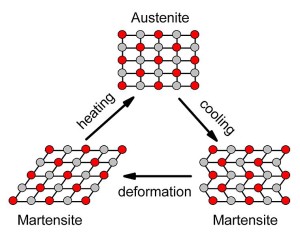|
METALS WITH MEMORY Certain alloys - so called Shape-Memory Alloys (SMA) - remember their original shape and can go back to it after being deformed. NiTiNOL (NiTi), the best known SMA, is a metal alloy of nickel and titanium. How does it work? The memory metal changes between two nanostructures, i.e., atoms rearrange at the nanoscale due to tension and temperature. The movement of each atom is imperceptible but by adding them all together deformation becomes visible at the macroscale.
Possible applications Most orthodontics equipment is made of nitinol. Stainless steel was previously used but memory metals make the process of moving teeth less painful and fewer visits are required. Some NiTi alloys respond to electricity. For example: the Mars rover Sojourner uses a NiTi wire to remove dust from solar panels. The NiTi wire is heated by electricity and this shortens the wire opening the hatch which removes the dust. In general, SMAs have multiple applications in medical technology including catheters, needles, stents to hold arteries open; in space and aircraft industry; orthodontics; as well as the automotive industry.
|












